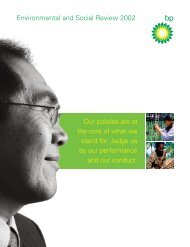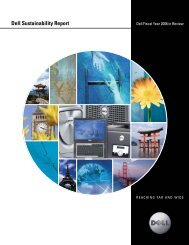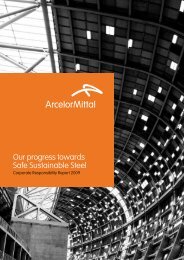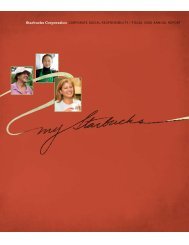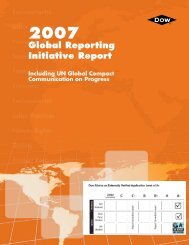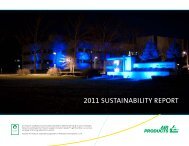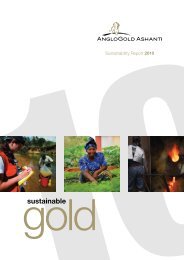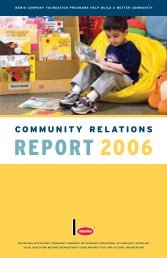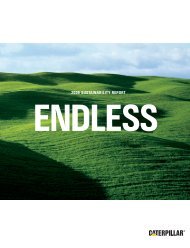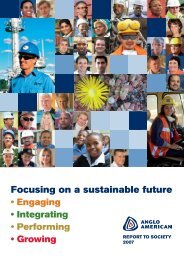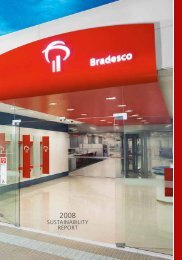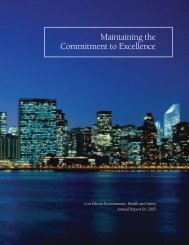Beyond the cup. - Starbucks
Beyond the cup. - Starbucks
Beyond the cup. - Starbucks
You also want an ePaper? Increase the reach of your titles
YUMPU automatically turns print PDFs into web optimized ePapers that Google loves.
THE COFFEE INDUSTRY— AN OVERVIEW —It is believed that coffee was first consumed asa hot beverage in East Africa during <strong>the</strong> 11thcentury. Today, coffee is one of <strong>the</strong> most popularbeverages, with $70 billion in retail sales wordwide.*Fur<strong>the</strong>rmore, <strong>the</strong> coffee industry provides a livelihoodfor an estimated 25 million people* (coffee farmersand <strong>the</strong>ir families) in more than 70 tropical coffeeproducingcountries.There are two commercially viable species ofcoffee – robusta and arabica. High-quality arabicacoffee is grown on all kinds of farms that rangefrom very small, family-run parcels to large-scaleestates located between <strong>the</strong> Tropics of Cancer andCapricorn, and typically situated at higher elevations.These elevations provide optimal climatic conditionsneeded to grow <strong>the</strong> type of coffee that is consideredspecialty grade. When more care is taken in growing,harvesting and processing <strong>the</strong> beans, <strong>the</strong> result ishigher-quality coffee. <strong>Starbucks</strong> only purchases <strong>the</strong>highest-quality arabica coffee beans. These coffees aresold under <strong>the</strong> <strong>Starbucks</strong> ® , Seattle’s Best Coffee ® andTorrefazione Italia ® brands.Arabica coffee is traded in two ways:• The majority of arabica coffee is traded as acommodity on <strong>the</strong> highly volatile New York “C”market. As global supply rises and falls, so do “C”prices. The average “C” price for a pound of coffeeduring fiscal 2005 was $1.04.• Higher-quality arabica beans are sold as specialtycoffee, which represents 10 percent** of totalworldwide coffee purchases. Prices for specialtycoffee are often negotiated at higher prices than<strong>the</strong> “C” offers in order to compensate farmers forquality. Coffee can be purchased from exporters,brokers, cooperatives and in some cases, farms.C.A.F.E. PracticesIn 1998, <strong>Starbucks</strong> began to integrate conservation principlesin our coffee buying practices through our partnershipwith Conservation International (CI). Three years later, wecollaborated with CI to create and pilot <strong>Starbucks</strong> PreferredSupplier Program (PSP) that was based on a set of socially andenvironmentally responsible coffee buying guidelines.These early efforts laid <strong>the</strong> groundwork for what eventuallybecame Coffee and Farmer Equity (C.A.F.E.) Practices.Formally introduced in fiscal 2004, C.A.F.E. Practices wasdesigned to assure high-quality coffee is grown and processedwith environmental sensitivity and social equity throughoutour coffee supply chain. Program improvements were madein fiscal 2005 by Scientific Certification Systems (SCS),a third-party evaluation and certification firm retained by<strong>Starbucks</strong> for <strong>the</strong> development, training and auditing ofC.A.F.E. Practices.OUR GUIDELINES FOR C.A.F.E. PRACTICESC.A.F.E. Practices helps ensure that <strong>Starbucks</strong> purchasescoffee that is grown and processed in a sustainable mannerby evaluating <strong>the</strong> social, environmental and economic aspectsof coffee production. The guidelines include 28 indicatorsagainst which suppliers (farmers, cooperatives, processorsand exporters) are evaluated. With <strong>the</strong> exception of <strong>the</strong>indicators for quality and economic transparency, whichare prerequisites, all o<strong>the</strong>r indicators have been assigned aminimum and a maximum number of points.Suppliers need to earn <strong>the</strong> minimum points in each scoredarea, representing social and environmental criteria. Finalscores are determined by independent, third-party verifiers,a process monitored by SCS. <strong>Starbucks</strong> looks at <strong>the</strong> pointsearned in each section to decide each supplier’s status.In fiscal 2005, <strong>Starbucks</strong> purchased 76.8 million pounds(34.8 million kilograms) of coffee from C.A.F.E. Practicessuppliers in seven countries. There are three status levels forC.A.F.E. Practices suppliers: Strategic, Preferred, and Verified.<strong>Starbucks</strong> buys on a preferential basis from C.A.F.E. Practicesapproved suppliers.Of <strong>the</strong> C.A.F.E. Practices coffee we purchased in 2005, <strong>the</strong>percentage from each supplier group is as follows:• Strategic (score of 80% and higher in social andenvironmental areas): 27%• Preferred (score of 60% and higher in social andenvironmental areas): 11%• Verified (score of less than 60% in social andenvironmental areas): 62%* International Coffee Organization** Specialty Coffee Association of America18OUR WORLD OF PRODUCTS



